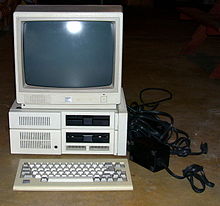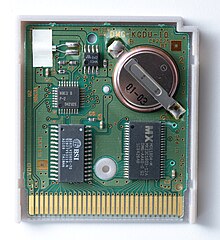Cartridge (computing)




A ROM cartridge, sometimes referred to simply as a cartridge, is a removable casing containing read-only memory devices intended to be connected to an electronics device. consumption, such as a personal computer or a video game console. ROM cartridges can be used to load software, such as video games, or other application programs.
The cartridge slot could be used for hardware additions, for example speech synthesis. Some cartridges had battery-backed static random access memory allowing the user to save information, such as game scores, each time they were used.
ROM cartridges allowed the user to quickly load and access programs and data without the need for a disk drive, which was an expensive peripheral during the personal computer era, and without the use of cassettes, which were sequential, slow, and often unreliable. An advantage for the manufacturer was the relative safety of distributing software in cartridge form, which was difficult for end users to replicate. However, cartridges were expensive to manufacture compared to floppy disks or CD-ROMs. Since disk drives became more common and software expanded beyond the practical limits of their size, cartridge slots disappeared from later consoles and computers. The cartridges are still used today with the Nintendo Switch hybrid game console
Use
A cartridge is a container that usually houses a type of rigid external memory, which connects to an electronic device such as: a mobile phone, a PDA, a computer, a game console, a digital camera, etc. Unlike the optical disc format, the cartridge format has no moving parts.
Initially, each manufacturer created a cartridge for its product, until the birth of standards such as EEPROM, flash memory or memory card. There are several packaging standards that contain memory cards, promoted and manufactured by most multinationals dedicated to hardware production.
Some digital devices read more than one type of memory card cartridge to ensure compatibility. The cartridges are resistant to external scratches, dust, and some water, which have plagued previous forms of portable storage such as floppy disks, compact discs, and DVDs.
Video games
The use of cartridges, compared to other options such as optical discs, responds to a long list of factors. The manufacturing price, which once a certain level of units is reached, is very low, in some cases, such as video game consoles, control over distributors and product manufacturers, who are obliged to use the patent. The cartridge format in video game consoles also allowed the inclusion of chips and special parts within the cartridge itself that expanded the capabilities of the standard console for each title that included it, such as the Super FX chip included in certain Super Nintendo cartridges or the chip Konami's SCC on some of their cartridges for the MSX platform, for example. In general, cartridges provide some guarantee to control the software that appears for a platform, at least compared to common media such as CDs or DVDs. Additionally, a cartridge has no moving parts, so a program is less likely to be damaged if it receives a knock while it is reading. Or get blocked by a bump while traveling by car or simply raising your arms to rest for a few seconds. They are very appropriate for children to use.
This system became popular with the first home computers, such as the Commodore 64, or the Atari 800XL, which included a special port for connecting cartridges with programs in a ROM memory. The advantage of cartridges over other media is instant availability, no charging time, and greater resistance to damage.
From the early 1980s to the first half of the 1990s, all video game consoles were cartridge-powered (with the exception of portable video game consoles). When CD technology began to be used as data storage, most companies stopped using cartridges and switched to CDs, since the latter were much cheaper and had a larger capacity. Nintendo resisted alone, and did not create a system based on optical discs until several years later; instead it chose to manufacture its "next generation" based on cartridges, the Nintendo 64. This performance was questioned by many employees, who maintained that cartridge games could not be as large or complex as CD games on competing consoles such as the Sony PlayStation. The economic consequences that the company suffered as a result of its audacity marked the end of cartridge consoles; in fact, Nintendo's next release, the GameCube, featured a DVD-based format. However, Nintendo's pocket consoles, which practically enjoys a monopoly, continued to use cartridges. The Nintendo DS uses a specific memory card format, the SD card. Meanwhile, Sony has chosen to combine the two platforms in its portable video game console, the PlayStation Portable: using optical format for video games, called UMD and developed by Sony, and at the same time allowing downloading of games and updates for them, as well as all types of multimedia content on a cartridge medium called Memory Stick.
Music
The 8-track sound system is considered a cartridge variety. Here, the cartridge contains a sound tape; In this way different contents are provided using the same player. The cartridge allows for easier handling of the tape, while being a stronger system than having a loose tape. In 1998 they were discontinued.[citation needed]
Contenido relacionado
On a silver platter
The Residents
Lexicon